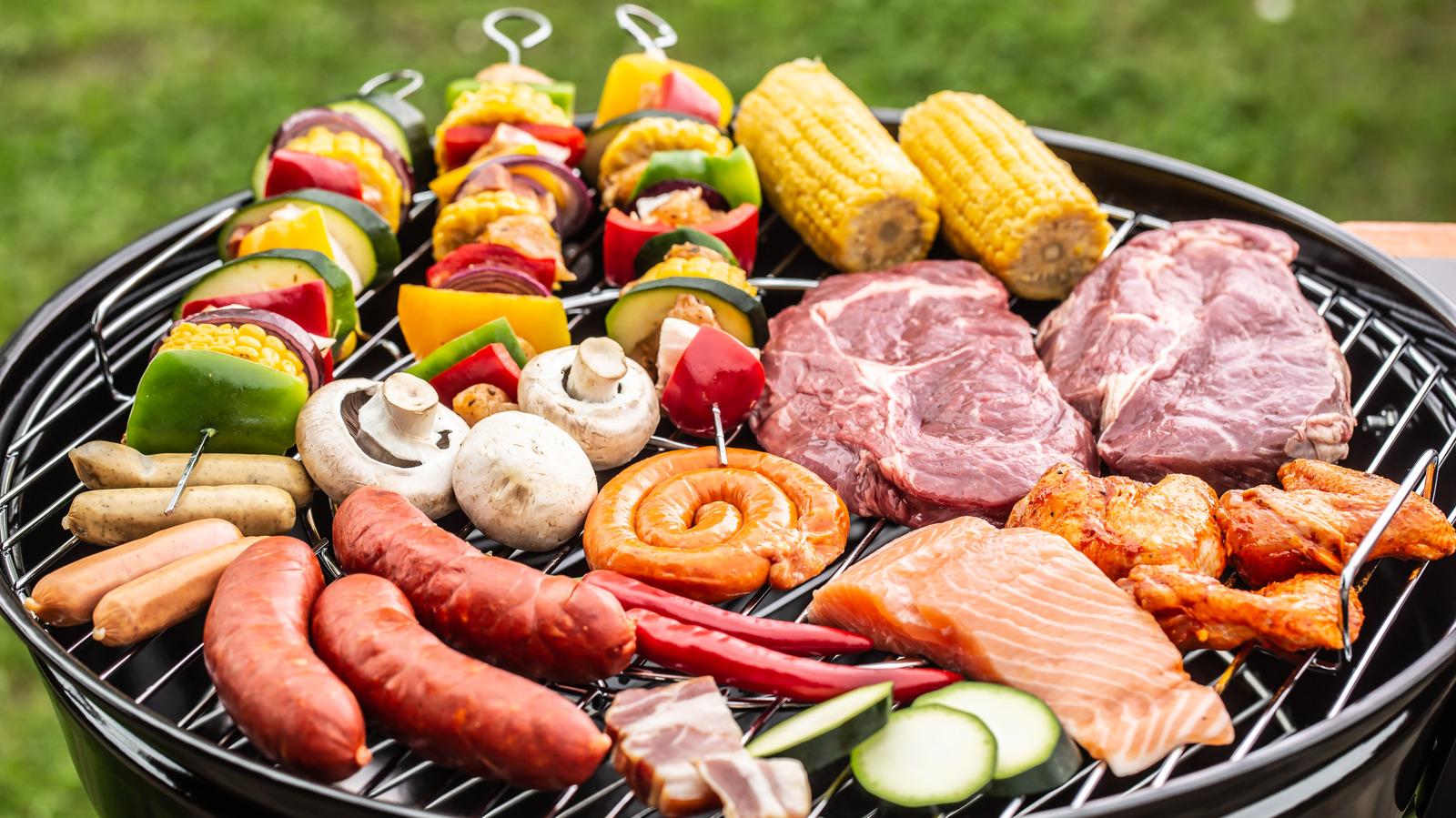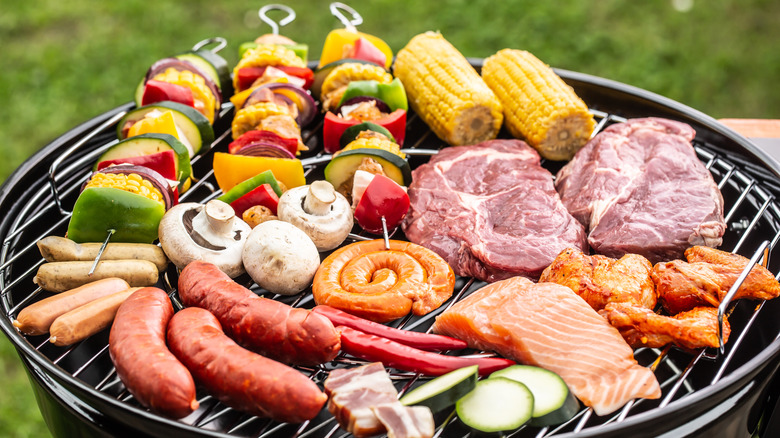
Simpleimages/Getty Images
We may receive a commission on purchases made from links.
Cooking with fire was undoubtedly a huge turning point in human evolution. However, the first barbecue grill that was safe and easy for the average person to use wasn't invented until 1952. Over the past 70 years, barbecues have become a staple in America, from restaurants to backyard gatherings. For many, heating up the grill for the first time is a special tradition to welcome spring each year as well.
When most people think of barbecue foods, they start drooling over hamburgers, hot dogs, corn on the cob, and maybe even some steaks, chicken breasts, or ribs. American barbecue food hasn't always boasted this kind of menu, though. If you ask your grandparents what backyard barbecues were like in their day, the results might shock you.
How different was barbecue food two or three generations ago, and have any old-fashioned recipes withstood the test of time? Read on to see what your grandparents' barbecue spread might've looked like and find out why some dishes aren't as popular today.
Huli huli chicken
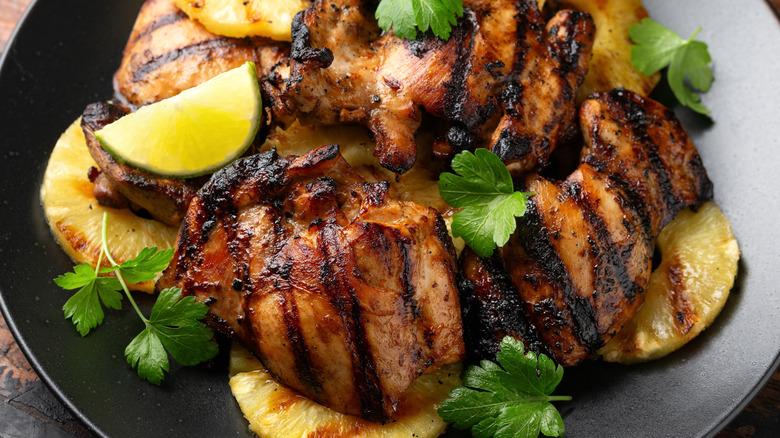
DronG/Shutterstock
It's fascinating to reflect on times when America wasn't the 50 states we know today. Hawaii became part of America in 1959, which means that many people who are still around might remember this historical event and the major tourism boom that followed. For decades, television, newspaper, magazine, and radio ads highlighted Hawaii as a glamorous place with a fun culture.
It should come as no surprise to hear that everyone on the mainland wanted to recreate meals from their vacation or try Hawaiian food for the first time if they couldn't afford the flight. This is why dishes like huli huli chicken were a major hit back in the day. Not many people are aware of it today due to a steep decline in advertising.
Huli huli marinade is refreshingly simple, sweet, and savory. Recipes call for brown sugar, ketchup, soy sauce, sherry, minced garlic, and ginger. The secret to success is reserving a bit of the marinade so you can use it as a glaze once the meat is almost done cooking. The final result is sticky and delicious. You can marinate any meat in this mixture, but chicken thighs hold up beautifully on the grill.
Ambrosia salad
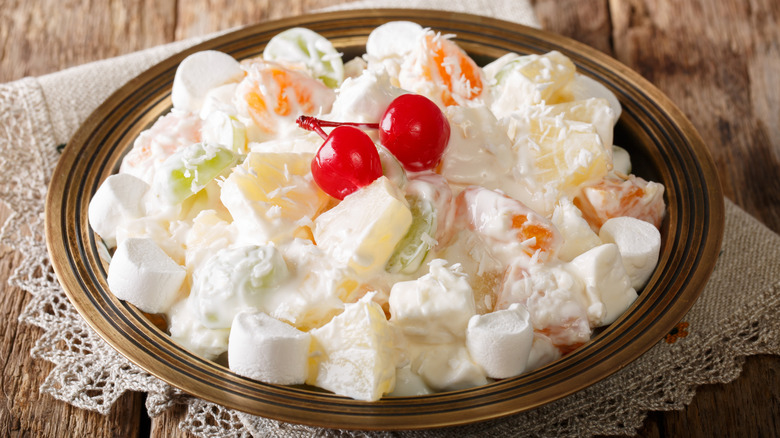
Alleko/Getty Images
One vintage side dish that always turned up at barbecues is ambrosia salad. This polarizing recipe is made with whipped cream, yogurt, canned fruits, shredded coconut, and mini marshmallows. The sweetness overload may lead you to believe that ambrosia salad earned a place on the dessert table, but people treated it as a side dish. If you're the kind of person who feels a little nervous about your mashed potatoes and steak touching, ambrosia salad getting close to any other food on your plate could make you downright queasy.
Ambrosia salad hasn't gone extinct, but it's mostly been banished to the South. Some families make it during holidays and cookouts because it reminds them of beloved older family members. You won't be the star of any barbecue if you bring this dish, but everyone might have fun trying this blast from the past if they've never heard of it before.
BBQ mutton
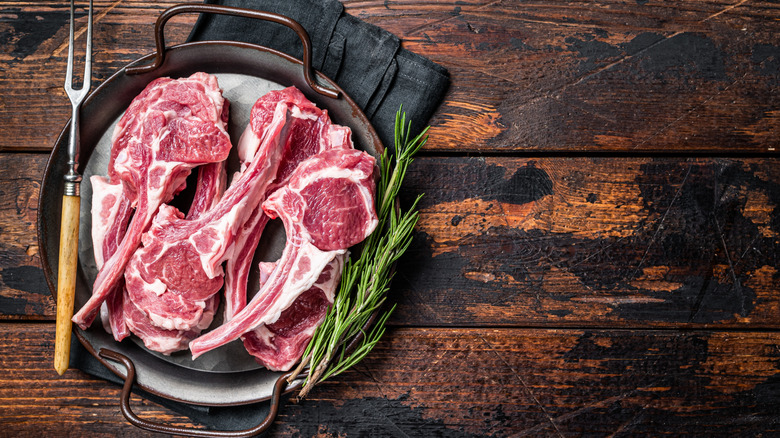
Mironov Vladimir/Shutterstock
Animal agriculture in America is all about chickens, cows, and pigs nowadays, but other animals used to be quite popular. In the 1800s, many Americans ate sheep because there was plenty of land to raise them on, plus they provided wool. Industrialization caused many people to move into big cities without farmland, which meant that sheep were struck off the menu for lots of folks. Mutton, which is meat from sheep that are at least 1 year old, started to fade from people's memories.
Animal agriculture has finally caught up to population demands, even though many people remain in urban areas today. Why isn't mutton available in most grocery stores, then? Mutton has a reputation for being tough, and most home cooks would feel lost trying to prepare it.
Some regions in America never stopped raising and serving sheep, though. If you ever visit Western Kentucky, you'll have the chance to taste barbecue mutton that's juicy, flavorful, and tender. Residents have had hundreds of years to perfect their cooking methods, which involve using acidic ingredients to break down the meat and slow-cooking it for up to 22 hours. As long as you learn about the top mistakes to avoid when cooking lamb, this type of meat could start making a regular appearance in your meal rotation.
Cobb sandwiches
The origin of Cobb salad has been debated, but most culinary experts agree that it was invented in the 1930s by Robert H. Cobb. Cobb owned a restaurant called the Brown Derby in Los Angeles. Anyone who knows a chef understands that working in the kitchen isn't always glamorous. While professional chefs can prepare gorgeous, intricate meals for guests, many of them are exhausted after a long shift and throw together basic meals for themselves. This is how the Cobb salad came to be.
Cobb was hungry one evening, but too tired to commit to making a proper meal. He settled on salad and started tossing a bunch of things in it. Once he started sharing his combination of lettuce, chicken, hard-boiled eggs, bacon, tomatoes, avocado, blue cheese, and French dressing with others, it took off as an American staple.
Cobb salad was featured in every restaurant and many get-togethers. People even loved it enough to transform it into other dishes, such as Cobb salad sandwiches. Wrapping the ingredients in a tortilla or putting them between two slices of bread makes the salad portable and more enjoyable to eat.
Today Cobb salad is still around in many restaurants, but it's not trendy enough for barbecues anymore. One potential reason is that blue cheese scares casual eaters off. Maybe folks want a basic salad with lettuce and only a couple of veggies so it can act as a palate cleanser between bites of fatty meats and decadent carbs.
Seven-layer salad
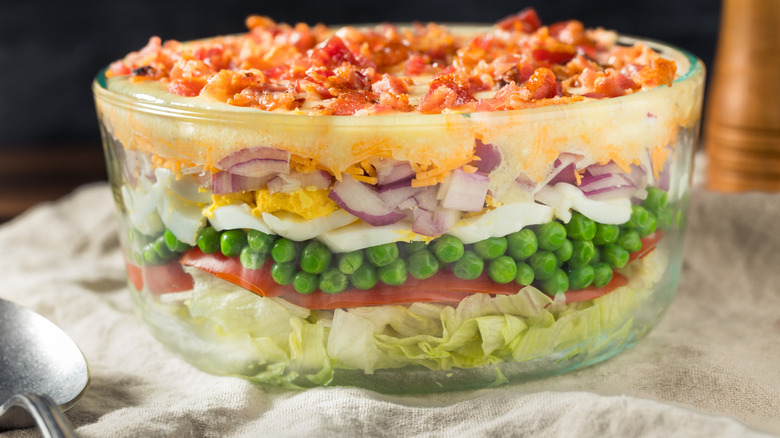
Brent Hofacker/Shutterstock
Most people would agree that seven-layer dip is alive and well, thanks to its popularity at Super Bowl watch parties and other casual events. However, lots of people have never heard of a seven-layer salad.
Working from the bottom, a seven-layer salad has layers of romaine lettuce, onion, peas, tomatoes, hard-boiled eggs, cheddar cheese, and bacon. It also has a layer of creamy sauce, which is usually made with mayonnaise or sour cream. Seven-layer salads can feature different ingredients, such as shredded carrots or cauliflower florets, depending on who's making it. The beauty of the salad is that you can throw in anything you want as long as the presentation has fun layers.
Not much is known about the history of the seven-layer salad, except it seems to be a dish that was born in the South but has taken root in the Midwest. You might be able to find a seven-layer salad on the table at a family barbecue in Oklahoma or Ohio, but the dish isn't widely known across the country nowadays. Most people like their salad dressings already well mixed, so maybe digging through a thick layer of mayo to get to the vegetables feels too uninviting for most people.
Grilled short ribs of beef
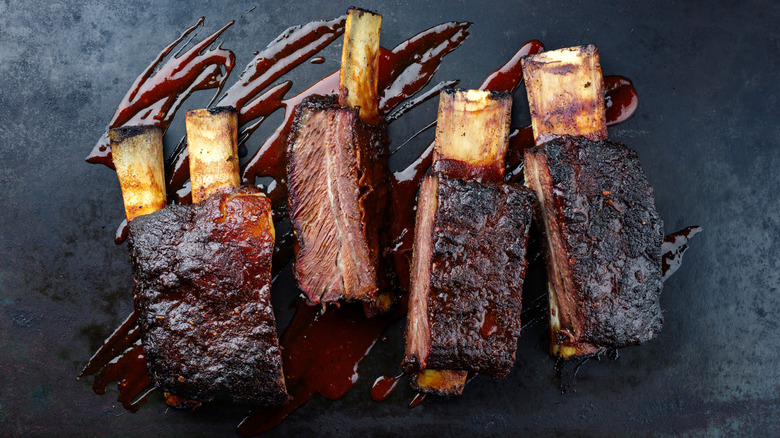
hlphoto/Shutterstock
It's always interesting to see photos of old cookbooks online. Leafing through grandma's collection, hunting in a thrift store, or digging around the attic can help us rediscover recipes that people used to be obsessed with. One Reddit user named YogurtclosetOk4440 shared a series of photos from a 1969 barbecue cookbook on r/Old_Recipes.
One is a basic beef short rib recipe for the grill. This recipe calls for a whopping 6 pounds of meat, which gives us an interesting glimpse into the past. Just like how lobsters used to be affordable enough to serve to prisoners, short ribs were once an inexpensive cut of meat. Short ribs are still delicious and popular, but they're likely not a big part of American barbecues anymore due to the notable increase in price.
The 1969 short rib recipe called for creating a marinade with tomato sauce, cider vinegar, dry mustard, salt, pepper, hot red pepper sauce, minced onion, garlic, and vegetable oil. After reducing these ingredients on the stove and marinating the short ribs overnight, home cooks are instructed to take out the meat but save the marinade for basting. Modern food safety protocols urge cooks to throw out anything that's been in contact with raw meat, so be sure to make extra sauce and set it aside if you decide to recreate this vintage barbecue recipe.
Gulfland chicken
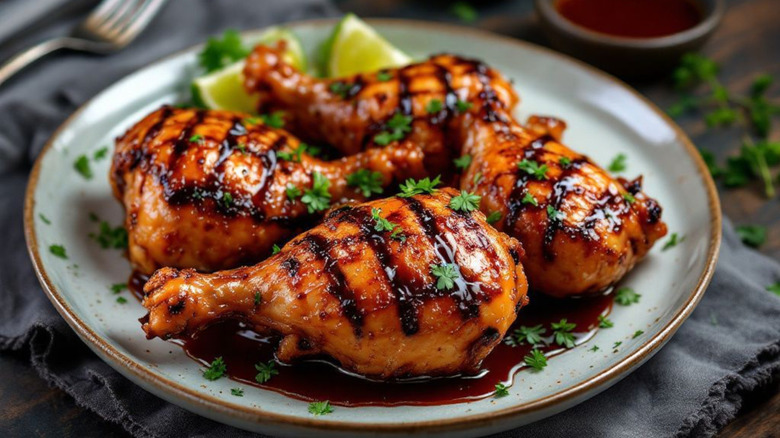
soded msy/Shutterstock
If you have a bunch of raw chicken sitting in your fridge that you wanted to eat but forgot to marinate the night before, Gulfland chicken could save the day. Instead of letting the chicken soak up a marinade for several hours, this vintage recipe tries to keep things simple by glazing the meat throughout the grilling process.
Gulfland chicken comes from a 1954 cookbook called "Barbecues!" Interestingly enough, the author of the recipe tells home cooks to wash and dry their chicken before grilling. People have been debating whether they should wash chicken for decades, but the verdict is that everyone's best odds are keeping chicken away from the sink. If you're curious about how Gulfland chicken tastes, skip this step and dive right into preparing the glaze.
Gulfland chicken gets its flavor from chicken bouillon, ketchup, Worcestershire sauce, grated horseradish, sugar, salt, chili powder, cayenne, chopped onion, and garlic. For maximum food safety, use a spoon to pour the sauce on top of the chicken, then use a basting brush to spread it around. This will help you prevent cross-contamination. The author recommends basting the chicken two to three times on each side as it grills.
Since there are a million sauce recipes for barbecued meats nowadays, it's understandable why Gulfland chicken lost its footing. The ingredients may not seem like anything special, but it's always good to have a basic yet reliable sauce that can save you when you're scrambling for a last-minute meal.
Fancy franks
For the uninitiated, fancy franks are diced-up hot dogs and pineapple chunks that are grilled on skewers, then coated in a zippy sauce. The sauce contains chopped celery, beef bouillon, salad oil, dry mustard, salt, horseradish, white wine, Tabasco sauce, and Worcestershire sauce. Putting all of these ingredients into one kebab may seem odd at first, but the recipe hits every note you could ask for in a balanced dish.
It's clear that people love the idea of putting a bunch of ingredients on a skewer and grilling them since shish kebab remains a cookout classic, so why did fancy franks get shunned? Doing inventive things in the kitchen can spark backlash, and sometimes certain dishes grab everyone's attention. Putting pineapple on pizza dates all the way back to the 1960s, and this move has continued to be the center of many fiery food debates.
Highly processed, salty meats and sweet, juicy fruits are divine to some and downright appalling to others, so it's no wonder that other recipes that use this flavor combination have flown under the radar. If we can't all come to an agreement on Hawaiian pizza, then how can we even begin to discuss if fancy franks should be back on the menu? You may not want to post your fancy franks on social media if you're afraid of reigniting this debate, but they could be your new guilty pleasure.
Vintage BBQ burgers
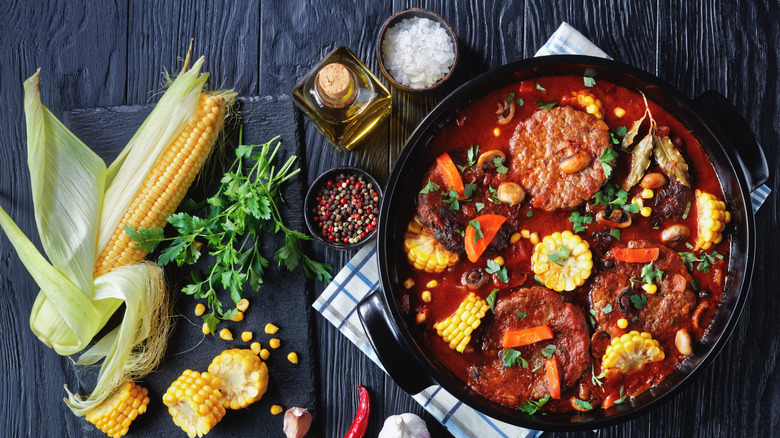
from my point of view/Shutterstock
What happens when you combine traditional barbecue burgers with meatloaf? "Cooking with Soup: A Campbell Cookbook" sought to answer this question in the '70s by combining the two flavors. The final result is burgers that are sauced up in a way that puts the juiciest beef you've ever had to shame.
Instead of ketchup, which people use in both traditional meatloaf and burgers, Campbell's teaches soup lovers how to use tomato soup as a flavorful sauce. To make it, you combine a can of Campbell's tomato soup, pickle relish, chopped onions, brown sugar, vinegar, and Worcestershire sauce. The pickles bring that classic burger flavor, while the Worcestershire sauce adds more body to the beef like a good meatloaf.
This Campbell's recipe likely fell out of favor because it's easier to squirt some ketchup on top of a grilled patty and spoon on some relish or use pickle slices. However, if you're guilty of letting leftovers go bad in your fridge, vintage BBQ burgers could hit the spot if you can't commit to preparing an entire meatloaf.
Cheese pudding
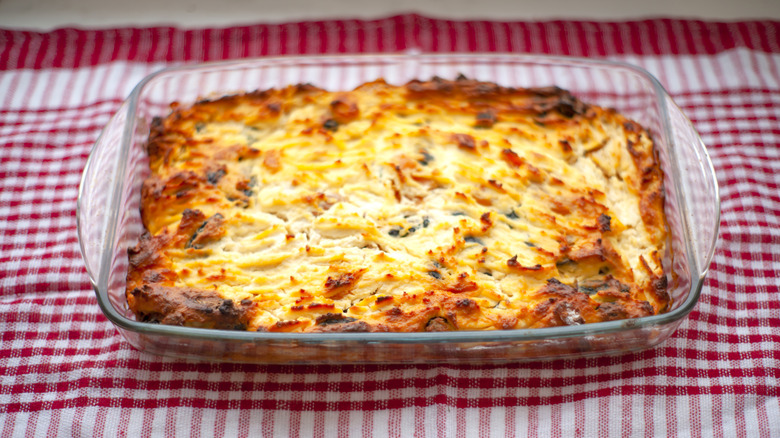
Boris Sv/Getty Images
If you've never heard of cheese pudding before, the name alone might make you think of a cursed Snack Pack filled with sweet cheese instead of chocolate or vanilla pudding. However, old-fashioned cheese pudding is more like bread pudding, except it's completely savory instead of sweet. You get the glorious custardy texture and the addictive flavors of cheesy bread.
Grandmothers all across America used to love whipping up a casserole dish filled with cheese pudding and bringing it to barbecues and other gatherings in their younger days. It heats up well, and it can even be prepared a day in advance.
According to "The Art of Southern Cooking," which was published in 1967, you only need a handful of ingredients. White sandwich bread, shredded cheddar cheese, salt, eggs, and whole milk come together in about 30 minutes.
Most people try to streamline their barbecues as much as possible, which means doing the majority of the cooking on the grill. Since this casserole tastes best warm, it would require a trip up to the kitchen to either bake or reheat. It's possible that potato salad took over since it can stay outside as long as it's chilled.
Mashed potato stuffed hot dogs
The exact origins of mashed potato stuffed hot dogs aren't clear, but they seem to have ties back to the 1940s. Some families also call this dish hot dog boats because the hot dogs become a vessel for creamy mashed potatoes and cheese. Lots of old recipes call for boiling the hot dogs and potatoes on the stove for convenience, but you could also use leftover mashed potatoes and finish preparing the meal on the grill.
After getting a nice char on the grill, slice the hot dogs down the middle without going all the way through so that both sides are still attached. Scoop some mashed potatoes onto the hot dogs, top with cheese, and move the hot dogs onto the indirect heat and close the lid to get everything warm and melted.
Hot dog boats aren't entirely extinct, but you won't find them at many cookouts nowadays. This is probably due to the fact that nothing beats the convenience of using store-bought hot dog buns as the accompanying carb.
Succotash
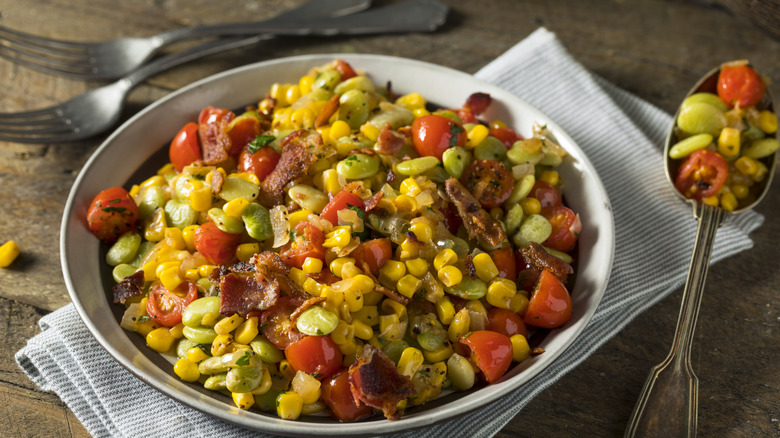
Bhofack2/Getty Images
Succotash goes way past our grandparents' time because it's a traditional Native American recipe. It's a flexible dish since it's a blend of all kinds of ingredients that are in season. Native Americans prepared succotash with things like corn, beans, game meat, acorns, walnuts, and roots. Once English colonists came into the picture, they adapted the recipe to include ingredients that were more familiar to them. Pork and root vegetables became popular picks.
One thing that has always stayed the same over the centuries is that corn is the star of any succotash. It was popular at barbecues because many Americans love eating corn with their barbecued meats. Succotash can act as a refreshing side dish because it's filled with other delightful veggies, including summer squash, ripe tomatoes, onions, and peppers. One possible reason why people don't make succotash much anymore is that traditional recipes call for shell beans, which aren't widely available in grocery stores.
Santa Maria-style barbecue tri-tip with salsa
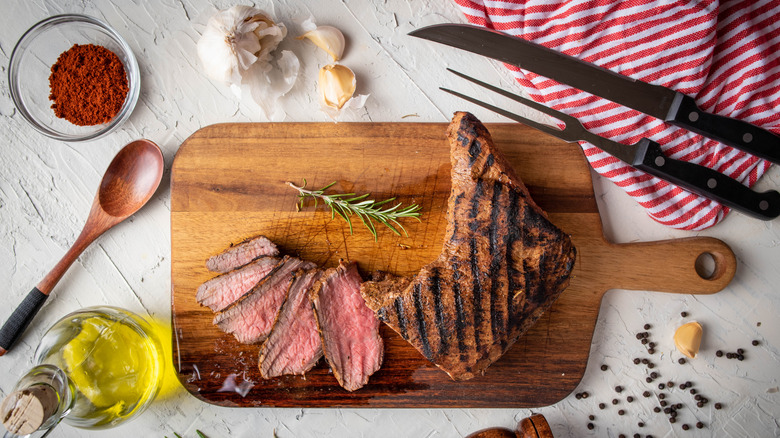
Ahirao_photo/Getty Images
California has a long tradition of barbecuing meats, beef in particular, over campfires that burned red oak. To freshen things up, the meat was usually served with fresh tomato salsa. There was a notable Santa Maria-style barbecue boom in the 1940s and '50s that continued to spread throughout the entire country as magazines picked up the trend.
Red oak barbecue reached its peak in the '80s when President Ronald Reagan served it at countless White House barbecues. If it was good enough for the president, that meant that every American was curious about what Santa Maria cuisine had to offer.
Some modern celebrity chefs like Bobby Flay still sing praises for Santa Maria-style barbecue, but there are many barbecue trends that bombard us on social media every summer. This could've caused red oak barbecue to slowly fade from public consciousness. In addition, not every home cook is even aware that red oak is something that's worth buying.
Mixed meat sausages
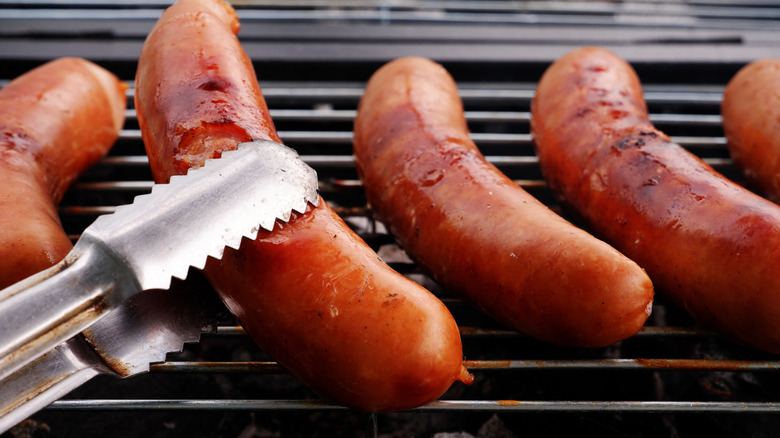
Valery Evlakhov/Shutterstock
When was the last time you made your own sausage? Sadly, most Americans prefer buying grill-ready sausages that tend to contain harmful additives as opposed to making some from scratch. One recipe for mixed meat sausages from 1969 proves that the process can be quite simple since you don't need to stuff the meat into casings with expensive equipment.
Using a 1 ½ to ¾ ratio of ground beef and ground pork, you can mix these meats together by hand with your favorite spices, form them into sausage shapes, and brush them with oil to prevent them from sticking on the grill. As long as you treat the sausages delicately and avoid flipping them too much, they could be just as tasty and healthier than store-bought sausages.
Since not many people know that making homemade sausages can be easy, it's no wonder that people in the modern age steer clear of recipes like these. If you have no qualms about making meatballs at home, try giving mixed meat sausages a try the next time you feel like firing up your grill.



